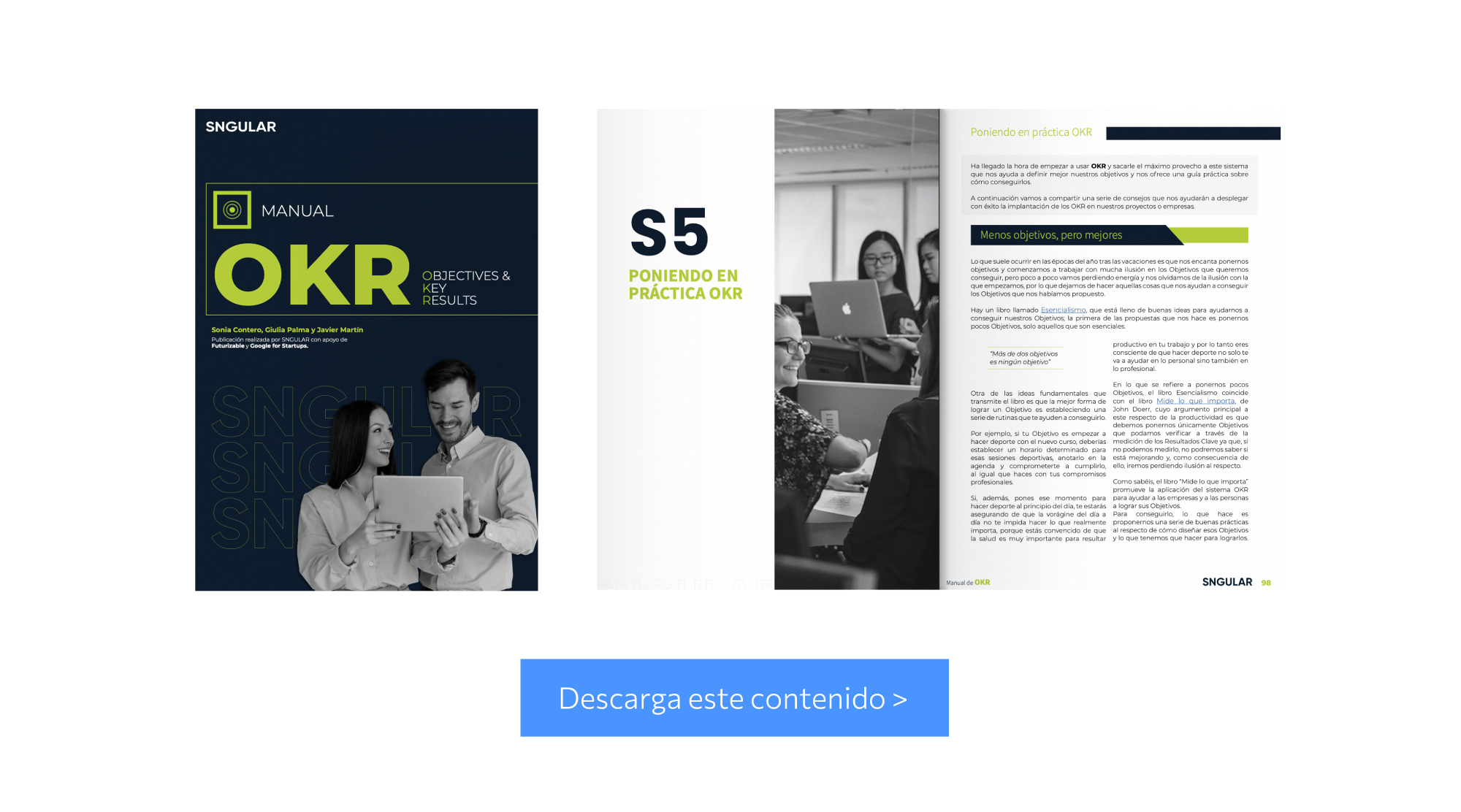
Step-by-Step Guide to Successfully Implementing OKRs
February 19, 2024
One of the biggest challenges for companies is to maintain well-focused objectives. Discover a simple step-by-step guide to successfully implement OKRs
The frenetic day-to-day activity that almost all companies experience often hinders the achievement of global objectives. To address this problem, OKR (Objectives and Key Results) was born, a business management methodology that helps companies define their objectives, work to achieve them, and evaluate the results obtained through quantitative and qualitative measurement of team progress.
OKRs can greatly benefit those companies that decide to digitally transform and put their customers at the center of their strategy. This methodology operates based on three elements: a Purpose, Objectives, and Key Results, which help answer the questions: why do we want to achieve it?, where do we want to go?, and how do we know if we have already arrived?.
In this article, we will present a simple guide to successfully implement the OKR methodology in your organization. One of the first necessary steps to address an OKR strategy is to analyze the current context, both external and internal, of organizations today, as there are many new aspects that are directly influencing the relationship between people and companies and are leading to a paradigm shift in work culture.
Analysis of the External Context
The expansion of remote work across various business sectors has led to a significant transformation in the mindset of workers worldwide. This shift has given rise to what is known as the "Great Resignation," term coined by Anthony Klotz, a professor at the University College London Business School, to describe the massive workforce exodus observed in many companies since 2021, when remote work was implemented across a wide range of global companies.
The reasons behind this labor migration stem from the fact that people's priorities and lifestyles have changed following the adoption of remote work, leading many to feel emotionally disconnected from their companies. This phenomenon has marked a shift from the traditional paradigm of having a lifelong job to a life characterized by multiple jobs. Now, individually, we decide which objectives we want to align ourselves with and under what conditions.

Analysis of the Internal Context
The world of business management is also changing. We increasingly see more companies starting to introduce agile methodologies and artificial intelligence with the aim of reaching the market faster and being closer to the needs of their customers. In this context, the OKR system has much to offer and becomes a practical tool of great utility for creating these new models of company culture.
One of the biggest challenges that companies face when implementing OKRs is to be agile in achieving their objectives in three fundamental areas, which must be perfectly aligned: strategy, technology, and people.
It is of little use to define the best objectives if the technology available to us will not allow us to interpret the results correctly or, more importantly, if the people in my organization and the teams are not identifying what is strategically important for the company. Each person should be oriented towards understanding how they contribute to what the organization needs.
Phases of Implementing the OKR Methodology
As we delve deeper into understanding OKR as a system that helps individuals and companies improve their businesses, we realize that it is a tool with great potential, but at the same time, it presents a complexity that requires us to make a necessary effort when implementing and developing it. Therefore, it is important to define an implementation plan through a series of phases that will help us integrate the methodology successfully.
Phase 1: Pre-Implementation Work
Explain to the entire organization the reasons why we are going to define OKRs
This step encourages us to think about why we do things, as we all know that it is much easier to reach the desired goal if we have a clear understanding of where we want to go. The problem at this point is that many workers don't really know why they do things, perhaps because their purpose is not clear, something that, surprisingly, happens in many companies.
Decide which individuals will start the process
For example, if the management team within a department initiates the process and then involves middle management, we would say that we are implementing the methodology from the top down or with a top-down approach. However, in OKRs, you can also start with an individual who decides to apply this tool to their own work, defining their own improvement objectives, so that once they have verified that it works, they can transfer it to their team or department, and ultimately to the entire company.
In this way, OKRs can also work from the bottom up, with a bottom-up approach, unlike other goal-based management methods that, being top-down, fail to succeed because they do not motivate the entire organization that does not feel involved. This bottom-up concept is very interesting in terms of motivation because it is clear that when a person sets a goal on their own initiative, the possibility of achieving it is much higher than if it is imposed upon them.

Phase 2: Designing the First OKRs
Define the Purpose
The first step is to define why we do things, that is, to reflect on the fundamental reason behind our actions and what drives us as a company to progress, improve, and compete in the market to serve our customers.
By establishing a clear purpose, we gain a deeper understanding of our customers' needs and desires. This allows us to align our strategies and efforts towards effectively solving their problems and meeting their demands.
Organize Collaborative Work Sessions
Collaborative learning is based on teamwork, where each individual contributes their skills and knowledge to achieve common goals.
For the effective progress of OKR implementation, it is essential to foster an environment where all participants work together and clearly understand the role each person plays within the organization. These collaborative sessions not only allow for sharing diverse ideas and perspectives but also strengthen the sense of belonging and team cohesion.
Designing the First OKRs
Writing good OKRs is probably the biggest challenge your organization will face. Despite understanding and being familiar with the theory of this system, implementing it in the field and adapting it to the idiosyncrasies of each company can be a difficult task. That's why we always recommend choosing a series of pre-defined OKRs as a reference and extrapolating them to our organization.

Phase 3: Project Launch
The implementation of OKRs: there are several paths when it comes to taking the first step and getting started with OKRs:
Implementing OKRs throughout the entire company from the start: This may be the best option when dealing with a company that already knows the framework and already has a culture open to change. This approach does not mean that all individuals in the company adopt the system at the same time, but rather that they do so over a shorter period of time, generally about three months.
Implementing it in two stages, starting within a pilot area: This way, we can more easily analyze the initial results and make adjustments, so that once they are well defined and functioning, we can roll them out to the rest of the organization. This process should not take more than six months.
Implementing it progressively: In this approach, which is safer than the previous ones but also takes longer, about six to nine months approximately, we will be implementing OKRs for teams one by one. This is the most recommended approach for organizations that find it more difficult to adapt to change.
Phase 4: Monitoring and Evaluation
Define the OKR review cycle
This process involves understanding which aspects of the strategy were effective, which were not, and how to proceed accordingly to continuously improve. Therefore, it is essential to develop an OKR review schedule that includes at least one quarterly follow-up meeting.
These meetings provide a crucial opportunity to assess the performance of the system and make adjustments as necessary. During these gatherings, teams can analyze the progress made, identify potential obstacles, and share insights to optimize the execution of objectives.
Communicate the results
Transparency is a fundamental pillar of the OKR philosophy, so it is crucial to share both quarterly and annual results with all involved teams. The effectiveness of OKRs is maximized when they are shared and fully understood by all members of the organization. This way, each individual understands how their contribution relates to the mission and objectives of the company.
To ensure effective communication and that all members are aware of what they need to do, it is recommended to design a detailed scheme describing all the stages an employee goes through when facing a significant cultural change. From the moment they first hear about this change to becoming a promoter capable of explaining how to implement it.
Choosing the Right Tool for Tracking and Communicating OKRs
While initially you can start using simple tools like Google Sheets or various Excel spreadsheets, in the long run, managing OKRs this way can become very complex. This is because, as the organization grows and develops, a greater capacity for collaboration, tracking, and data analysis is required to keep objectives and activities aligned. Technology tools specifically designed for OKR management offer advanced features that facilitate the process, such as assigning responsibilities, visualizing real-time progress, generating automated reports, and integrating with other teamwork platforms.
In this regard, while spreadsheets can be useful to start with, as the implementation of OKRs becomes more integral to the organization, it will be crucial to migrate to more specialized technological tools to ensure efficient and effective management of objectives and key results.
Tracking and Evaluation with CFR
It's common that once OKRs are set with their Objectives, Key Results, and Tasks, we become so immersed in our daily tasks that we lose sight of the fundamental reason behind our actions. Hence, it's crucial to regularly review the OKRs through CFR.
Integrating Conversations, Feedback, and Recognition (CFR) into OKR evaluation is essential to foster a culture of continuous improvement and commitment. During quarterly tracking meetings, not only are progress towards objectives examined, but open dialogues are also encouraged where teams share experiences and identify challenges, aiding in a better understanding of areas for improvement.

Ready to learn how to design your OKRs?
Download the latest version of our OKR manual and unlock the full potential of this methodology with our exclusive OKR manual! In it, you'll explore the essential foundations of this methodology, learning how to craft objectives and key results effectively to drive performance and organizational alignment. Additionally, you'll delve into real-life success stories, discovering strategies to overcome resistance to change and common challenges in OKR implementation.
Gain access to examples and practical cases, along with a detailed analysis of available digital tools for managing OKRs, all designed to assist you in implementing this powerful methodology and taking your organization to the next level. Download now and start turning your objectives into tangible results!
Considering Implementing OKRs in your organization and need help?
While OKRs may seem simple in theory, they require a significant shift in your organization's culture and processes. That's why it can be incredibly helpful to have support from professionals specialized in OKRs during the implementation process.
If you're interested in implementing OKRs but don't know where to start, we can assist you in launching this methodology through our specialized courses for individuals and businesses or our in-company training services. This way, you can progress towards a successful objective-driven management model. Feel free to contact us to inquire about anything you need to know regarding this methodology, with no obligations.

